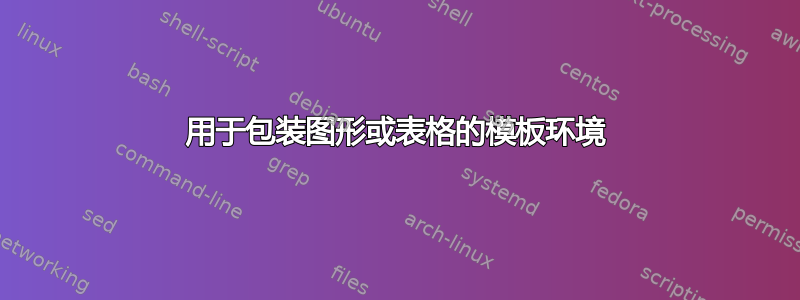
我需要生成多个\newenvironments,每个 s 对应我的\newtheorem以及 exsheets questions。但是,我想描述的问题并不特定于 exsheets。我的每个新环境都必须能够环绕一个图形。我已经成功地将question环境包裹如下 -
% https://tex.stackexchange.com/a/387448/26682
\newsavebox{\wrapquestionfigure}
\newenvironment{wrapquestion}[2]{ % #1 = points, #2 = figure, body = text of question
\savebox{\wrapquestionfigure}{#2}%
\noindent\minipage[t]{\textwidth}%
\rightskip=\dimexpr \wd\wrapquestionfigure+\columnsep\relax%
\question{#1}%
}{
\endquestion%
\endminipage\llap{\raisebox{\dimexpr-\dp\strutbox-\ht\wrapquestionfigure}{\usebox{\wrapquestionfigure}}}%%
}
它运行完美。现在我希望对包装 s 做同样的事情 \newtheorem。我的想法是创建一个模板\newenvironment,我将向其传递环境名称X以及参数。如果(最多一个)参数<arg>为空,它将调用\X,否则\X{<arg>}。
这是代码--
% new environment based on the above -- to wrap a figure or table around evironment X
\newenvironment{wrapfiginenv}[3]{
% #1 = environment X (question/thm/fact/ex/exc/exercise)
% #2 = arguments of that particular environment X (empty if none),
% #3 = figure or table
% body = body of environment X
\savebox{\wrapquestionfigure}{#3}%
\noindent\minipage[t]{\textwidth}%
\rightskip=\dimexpr \wd\wrapquestionfigure+\columnsep\relax%
\ifthenelse{ \euqal{#2}{} } {
\csname #1\endcsname
} {
\csname #1\leftbracechar#2\rightbracechar\endcsname
}
}{
\def\tmpcmd{end}
\expandafter\csname\expandafter\tmpcmd{}#1\endcsname
\endminipage\llap{\raisebox{\dimexpr-\dp\strutbox-\ht\wrapquestionfigure}{\usebox{\wrapquestionfigure}}}%%
}
无论我尝试什么排列组合
\def\tmpcmd{end}
\expandafter\csname\expandafter\tmpcmd{}#1\endcsname
不起作用。我哪里做错了?
这是一个 MWE——
\documentclass{article}
\usepackage{etoolbox,amsthm,adjustbox,tikz,ifthen}
\usepackage[headings=runin]{exsheets}
% new commands for wrapping questions
% https://tex.stackexchange.com/a/387448/26682
\newsavebox{\wrapquestionfigure}
\newenvironment{wrapquestion}[2]{ % #1 = points, #2 = figure, body = text of question
\savebox{\wrapquestionfigure}{#2}%
\noindent\minipage[t]{\textwidth}%
\rightskip=\dimexpr \wd\wrapquestionfigure+\columnsep\relax%
\question{#1}%
}{
\endquestion%
\endminipage\llap{\raisebox{\dimexpr-\dp\strutbox-\ht\wrapquestionfigure}{\usebox{\wrapquestionfigure}}}%%
}
% new environment based on the above -- to wrap a figure or table around evironment X
\newenvironment{wrapfiginenv}[3]{
% #1 = environment X (question/thm/fact/ex/exc/exercise)
% #2 = arguments of that particular environment X (empty if none),
% #3 = figure or table
% body = body of environment X
\savebox{\wrapquestionfigure}{#3}%
\noindent\minipage[t]{\textwidth}%
\rightskip=\dimexpr \wd\wrapquestionfigure+\columnsep\relax%
\ifthenelse{ \euqal{#2}{} } {
\csname #1\endcsname
} {
\csname #1\leftbracechar#2\rightbracechar\endcsname
}
}{
%\def\tmpcmd{end}
%\expandafter\csname\expandafter\tmpcmd{}#1\endcsname
\endminipage\llap{\raisebox{\dimexpr-\dp\strutbox-\ht\wrapquestionfigure}{\usebox{\wrapquestionfigure}}}%%
}
\newtheorem{thm}{Theorem}[section]
\newtheorem{fact}[thm]{Fact} % there are several more such environments
\begin{document}
\begin{fact}
\adjustbox{valign=t}{\begin{minipage}[t]{.6\textwidth}
Using the adjoining table and we can compute cross products of any vector as demonstrated in the classroom.
\end{minipage}}%
\hfill%
\adjustbox{valign=t}{\begin{minipage}[t]{.3\textwidth}
\begin{center}
\begin{tabular}{|cc|}
$\hat{i}\times\hat{j}=\hat{k}$ & $\hat{j}\times\hat{i}=-\hat{k}$ \\
$\hat{j}\times\hat{k}=\hat{i}$ & $\hat{k}\times\hat{j}=-\hat{i}$ \\
$\hat{k}\times\hat{i}=\hat{j}$ & $\hat{i}\times\hat{k}=-\hat{j}$ \\
\end{tabular}
\end{center}
\end{minipage}}
\end{fact}
\begin{wrapquestion}{1}{\begin{tikzpicture}
\draw[->] (0,0) -- (0,1.5) node[above] {$a (ms^2)$};
\draw[->] (-.3,0) -- (2,0) node[right] {$t (s)$};
\end{tikzpicture}}
If $\vec{C}=\alpha\vec{A}+\beta\vec{B}$ then $\vec{A}\cdot(\vec{B}\times\vec{C})+ \vec{B}\cdot(\vec{C}\times\vec{A}) + \vec{C}\cdot(\vec{A}\times\vec{B})$
\end{wrapquestion}
% the idea is to make the following work just like the question above.
%\begin{wrapfiginenv}{fact}{}{\begin{tabular}{|cc|}%
% $\hat{i}\times\hat{j}=\hat{k}$ & $\hat{j}\times\hat{i}=-\hat{k}$ \\
% $\hat{j}\times\hat{k}=\hat{i}$ & $\hat{k}\times\hat{j}=-\hat{i}$ \\
% $\hat{k}\times\hat{i}=\hat{j}$ & $\hat{i}\times\hat{k}=-\hat{j}$ \\
% \end{tabular}}
% Using the adjoining table and we can compute cross products of any vector as demonstrated in the classroom.
%\end{wrapfiginenv}
\end{document}
答案1
\def\tmpcmd{end}
\expandafter\csname\expandafter\tmpcmd{}#1\endcsname
\expandafters的序列会扩展,{ 但是这是一个不可扩展的标记,因此它不会扩展。
所以这和
\csname end{#1}\endcsname
它将生成一个名称中带有的 csname {,它几乎肯定不会被定义,因此它将充当\relax。
你大概想要
\csname end#1\endcsname
\endproof如果#1是,它将执行,proof 或者更简单,你可以使用
\end{#1}
并使用\begin{#1}启动环境。
现在提供了 MWE,如果你取消注释第二个环境,你会得到
! Undefined control sequence.
<inserted text> \euqal
大概\equal是故意的。然后按照上述方法修复 csname 用法会导致
\documentclass{article}
\usepackage{etoolbox,amsthm,adjustbox,tikz,ifthen}
\usepackage[headings=runin]{exsheets}
% new commands for wrapping questions
% https://tex.stackexchange.com/a/387448/26682
\newsavebox{\wrapquestionfigure}
\newenvironment{wrapquestion}[2]{ % #1 = points, #2 = figure, body = text of question
\savebox{\wrapquestionfigure}{#2}%
\noindent\minipage[t]{\textwidth}%
\rightskip=\dimexpr \wd\wrapquestionfigure+\columnsep\relax%
\question{#1}%
}{
\endquestion%
\endminipage\llap{\raisebox{\dimexpr-\dp\strutbox-\ht\wrapquestionfigure}{\usebox{\wrapquestionfigure}}}%%
}
% new environment based on the above -- to wrap a figure or table around evironment X
\newenvironment{wrapfiginenv}[3]{%%%%<
% #1 = environment X (question/thm/fact/ex/exc/exercise)
% #2 = arguments of that particular environment X (empty if none),
% #3 = figure or table
% body = body of environment X
\savebox{\wrapquestionfigure}{#3}%
\noindent\minipage[t]{\textwidth}%
\rightskip=\dimexpr \wd\wrapquestionfigure+\columnsep\relax%
\def\thisname{#1}%
\ifthenelse{ \equal{#2}{} } {%%%%<
\csname #1\endcsname
} {%%%%<
\csname #1\endcsname{#2}%%%%<
}%%%%<
}{%%%%<
\csname end\thisname\endcsname
\endminipage\llap{\raisebox{\dimexpr-\dp\strutbox-\ht\wrapquestionfigure}{\usebox{\wrapquestionfigure}}}%%
}
\newtheorem{thm}{Theorem}[section]
\newtheorem{fact}[thm]{Fact} % there are several more such environments
\begin{document}
\begin{fact}
\adjustbox{valign=t}{\begin{minipage}[t]{.6\textwidth}
Using the adjoining table and we can compute cross products of any vector as demonstrated in the classroom.
\end{minipage}}%
\hfill%
\adjustbox{valign=t}{\begin{minipage}[t]{.3\textwidth}
\begin{center}
\begin{tabular}{|cc|}
$\hat{i}\times\hat{j}=\hat{k}$ & $\hat{j}\times\hat{i}=-\hat{k}$ \\
$\hat{j}\times\hat{k}=\hat{i}$ & $\hat{k}\times\hat{j}=-\hat{i}$ \\
$\hat{k}\times\hat{i}=\hat{j}$ & $\hat{i}\times\hat{k}=-\hat{j}$ \\
\end{tabular}
\end{center}
\end{minipage}}
\end{fact}
\begin{wrapquestion}{1}{\begin{tikzpicture}
\draw[->] (0,0) -- (0,1.5) node[above] {$a (ms^2)$};
\draw[->] (-.3,0) -- (2,0) node[right] {$t (s)$};
\end{tikzpicture}}
If $\vec{C}=\alpha\vec{A}+\beta\vec{B}$ then $\vec{A}\cdot(\vec{B}\times\vec{C})+ \vec{B}\cdot(\vec{C}\times\vec{A}) + \vec{C}\cdot(\vec{A}\times\vec{B})$
\end{wrapquestion}
% the idea is to make the following work just like the question above.
\begin{wrapfiginenv}{fact}{}{\begin{tabular}{|cc|}%
$\hat{i}\times\hat{j}=\hat{k}$ & $\hat{j}\times\hat{i}=-\hat{k}$ \\
$\hat{j}\times\hat{k}=\hat{i}$ & $\hat{k}\times\hat{j}=-\hat{i}$ \\
$\hat{k}\times\hat{i}=\hat{j}$ & $\hat{i}\times\hat{k}=-\hat{j}$ \\
\end{tabular}}
Using the adjoining table and we can compute cross products of any vector as demonstrated in the classroom.
\end{wrapfiginenv}
\end{document}


